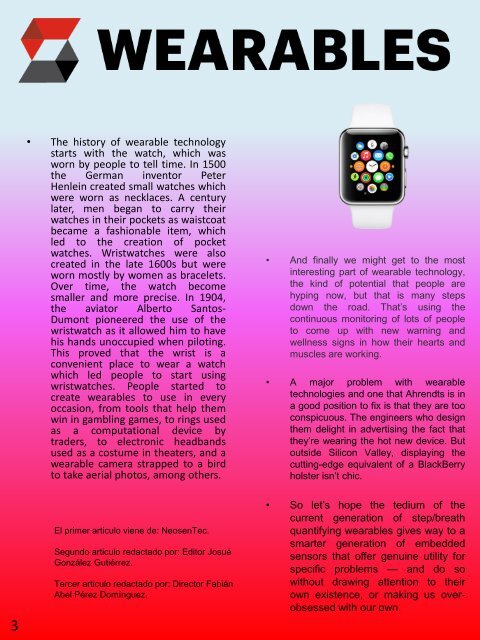Revista.
You also want an ePaper? Increase the reach of your titles
YUMPU automatically turns print PDFs into web optimized ePapers that Google loves.
• The history of wearable technology<br />
starts with the watch, which was<br />
worn by people to tell time. In 1500<br />
the German inventor Peter<br />
Henlein created small watches which<br />
were worn as necklaces. A century<br />
later, men began to carry their<br />
watches in their pockets as waistcoat<br />
became a fashionable item, which<br />
led to the creation of pocket<br />
watches. Wristwatches were also<br />
created in the late 1600s but were<br />
worn mostly by women as bracelets.<br />
Over time, the watch become<br />
smaller and more precise. In 1904,<br />
the aviator Alberto Santos-<br />
Dumont pioneered the use of the<br />
wristwatch as it allowed him to have<br />
his hands unoccupied when piloting.<br />
This proved that the wrist is a<br />
convenient place to wear a watch<br />
which led people to start using<br />
wristwatches. People started to<br />
create wearables to use in every<br />
occasion, from tools that help them<br />
win in gambling games, to rings used<br />
as a computational device by<br />
traders, to electronic headbands<br />
used as a costume in theaters, and a<br />
wearable camera strapped to a bird<br />
to take aerial photos, among others.<br />
• And finally we might get to the most<br />
interesting part of wearable technology,<br />
the kind of potential that people are<br />
hyping now, but that is many steps<br />
down the road. That’s using the<br />
continuous monitoring of lots of people<br />
to come up with new warning and<br />
wellness signs in how their hearts and<br />
muscles are working.<br />
• A major problem with wearable<br />
technologies and one that Ahrendts is in<br />
a good position to fix is that they are too<br />
conspicuous. The engineers who design<br />
them delight in advertising the fact that<br />
they’re wearing the hot new device. But<br />
outside Silicon Valley, displaying the<br />
cutting-edge equivalent of a BlackBerry<br />
holster isn’t chic.<br />
3<br />
El primer articulo viene de: NeosenTec.<br />
Segundo articulo redactado por: Editor Josué<br />
González Gutiérrez.<br />
Tercer articulo redactado por: Director Fabián<br />
Abel Pérez Domínguez.<br />
• So let’s hope the tedium of the<br />
current generation of step/breath<br />
quantifying wearables gives way to a<br />
smarter generation of embedded<br />
sensors that offer genuine utility for<br />
specific problems — and do so<br />
without drawing attention to their<br />
own existence, or making us overobsessed<br />
with our own.





